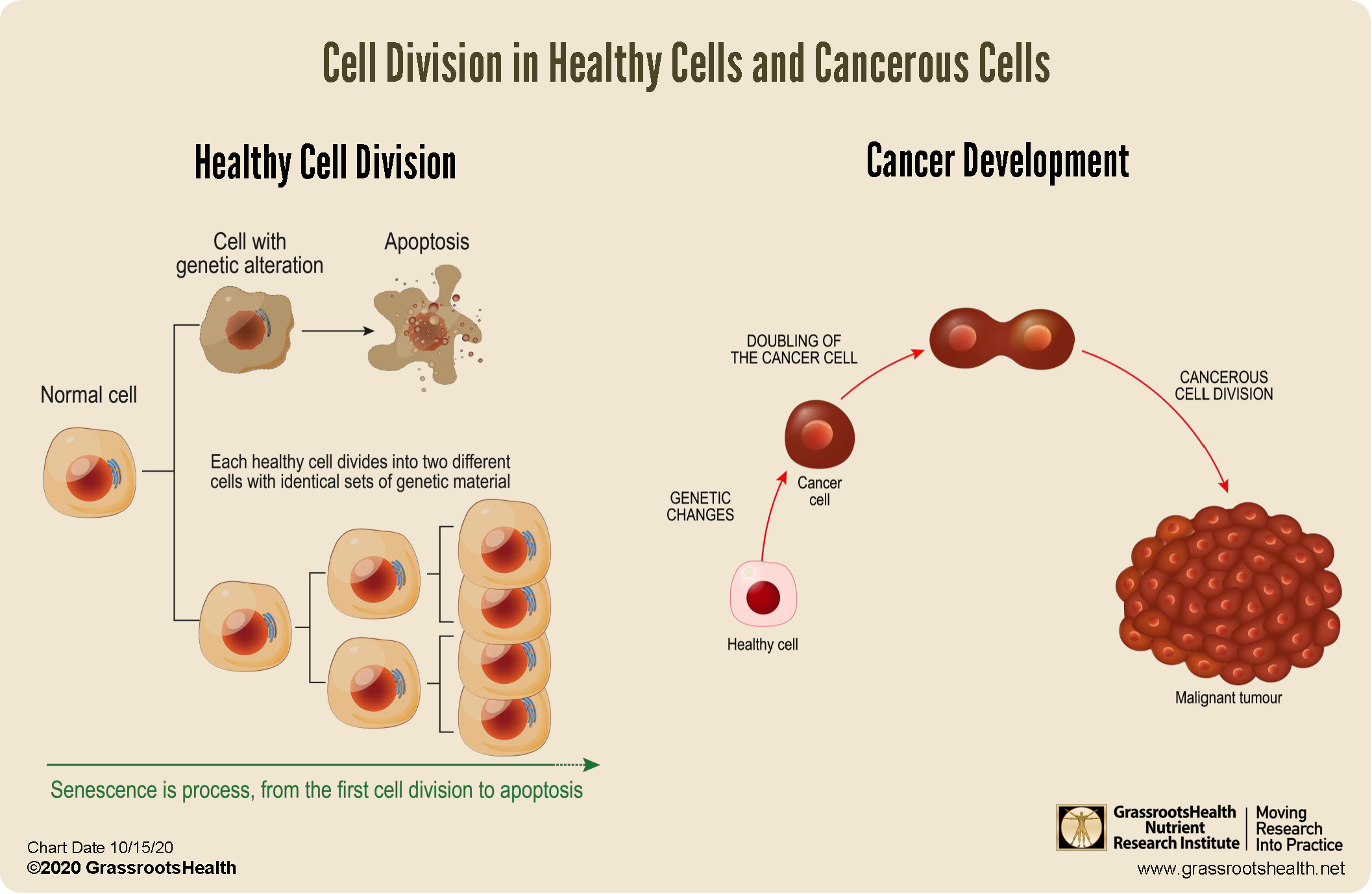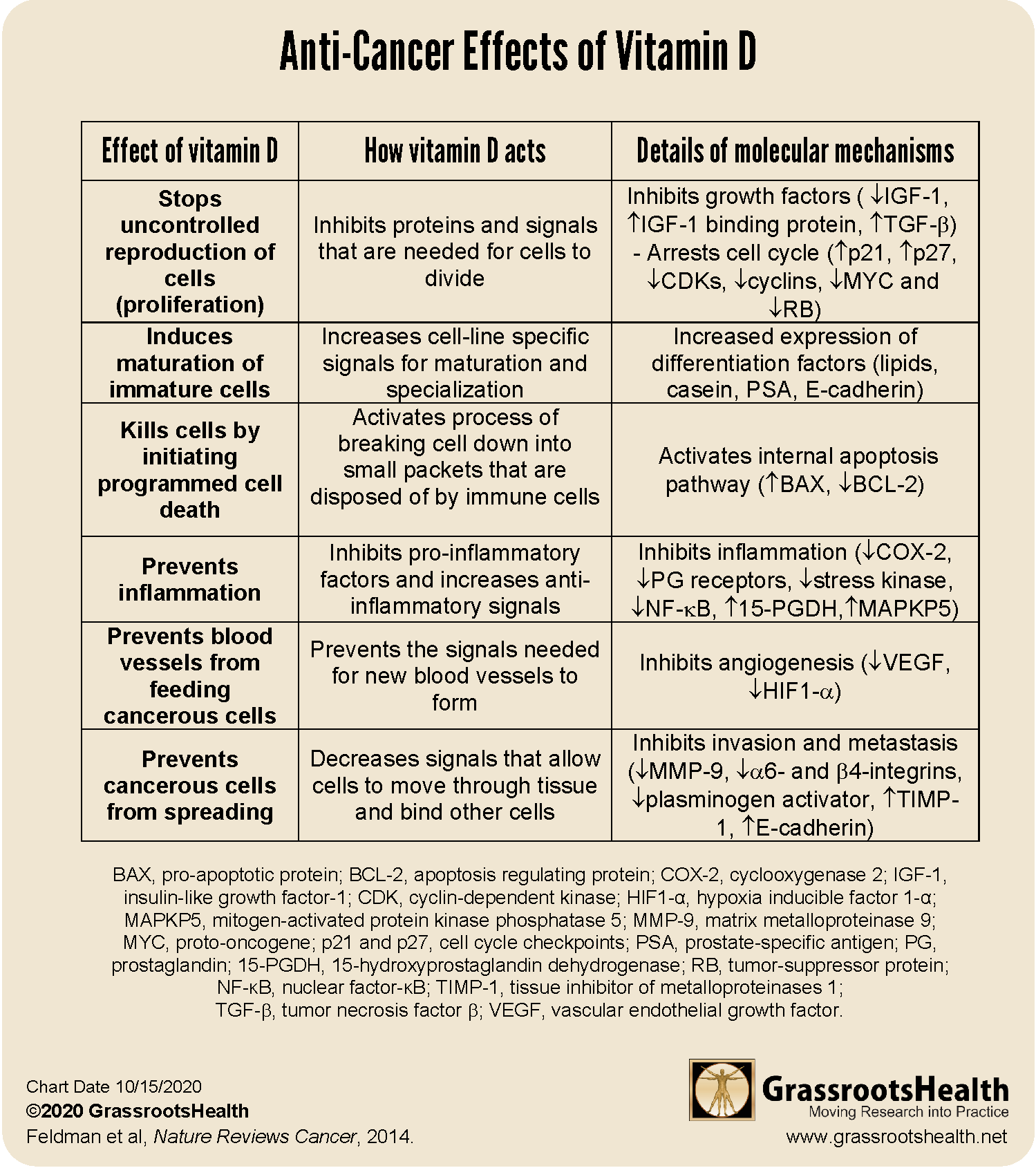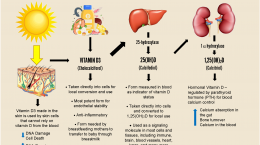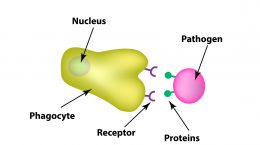Published on October 16, 2020
How does vitamin D work to help prevent cancer? Here is a simplified explanation of the multiple ways vitamin D can help the body to fight cancer.
 Over 40 years ago, Dr. Cedric Garland and his brother, Dr. Frank Garland, hypothesized that vitamin D could not only prevent rickets but may also act to prevent cancer. Today, evidence shows the benefits of having blood levels of vitamin D of at least 40 to 60 ng/ml include the prevention of certain types of cancer.
Over 40 years ago, Dr. Cedric Garland and his brother, Dr. Frank Garland, hypothesized that vitamin D could not only prevent rickets but may also act to prevent cancer. Today, evidence shows the benefits of having blood levels of vitamin D of at least 40 to 60 ng/ml include the prevention of certain types of cancer.
Recently we summarized the results from a 2018 paper published by GrassrootsHealth that showed women with vitamin D levels at or above 60 ng/ml had an 80% lower risk of breast cancer than women with levels less than 20 ng/ml. Other studies have related vitamin D levels (above 33 ng/ml) to increased survival rates in people with breast cancer, colon cancer, lung cancer or lymphoma and vitamin D supplementation to a 33% reduced risk of dying from colorectal cancer.
The VITAL study, which provided 2,000 IU/day of vitamin D, found that those who supplemented with vitamin D had a 24% reduced risk of cancer, and mortality from cancer was reduced by 25%.
Today we will explain HOW vitamin D works to prevent cancer and how it helps improve outcomes in people with cancer.
Vitamin D in the Body and its Metabolism
Whether it is produced from sun exposure or taken in from the diet or supplements, vitamin D is processed in the body through many steps from vitamin D3 into its hormonal form, “calcitriol,” before being broken down.
The kidneys are responsible for controlling blood levels of calcitriol, which is important for maintaining blood levels of calcium within a very narrow range. However, nearly every cell in the body can make its own calcitriol and use it; but this use is dependent upon having high enough vitamin D or 25(OH)D (the form of vitamin D we measure) in the blood.
Once calcitriol is made by the cells, it binds to the vitamin D receptor (VDR) and acts to turn genes “on” or “off.” If a gene is turned “on” it produces a protein that may act to stimulate or inhibit a biological process. If a gene is turned “off,” it prevents that protein from being made and thus any action that protein would have. This is predominantly how vitamin D regulates biological pathways in the body, several of which are important in the development and progression of cancer.
How Does Cancer Develop?
In general, normal healthy cells go through a life cycle that is a series of growth and development steps, as depicted in the diagram below. This process is controlled by numerous checkpoints and signals. The life cycle starts with its “birth” – the formation of a new cell within another cell – and reproduction – the division of those cells to make two new cells that mature into more specialized cells which carry out specific functions in the body. If an abnormality is detected, the cell undergoes apoptosis, an internally triggered cell death.
Conversely, a cancerous cell stays immature and the cell cycle actively continues without responding to the usual checkpoints, allowing the cell to continue to divide unregulated. A cell can become cancerous when conditions or signals that control the life cycle break down. There are many ways that the life cycle can be interrupted, leading to the development of a cancerous cell, including changes in signals that: i) control cell birth, ii) interfere with the regulation of cell replication, iii) disrupt cellular maturation, or iv) promote conditions that increase oxidative stress or cell damage.
Vitamin D actions counteract the breakdown of the cell cycle and the growth and spread of the cancerous cells.
Anti-Cancer Effects of Vitamin D
Calcitriol, or hormonal vitamin D, controls multiple pathways associated with the life cycle of the cell including those involved with reproduction, maturation and programmed death. Calcitriol regulates the production of a number of signals and growth factors at the genetic level – meaning it controls whether those factors are made or not. As detailed in the table below, some of the signals turned on by vitamin D stimulate growth, development, maturation and programmed cell death while other signals inhibit inflammation, prevent blood vessels from being made that can feed cancer cells, and stop the spread of the cancer to other parts of the body.
Specifically, calcitriol stops the uncontrolled reproduction of cancer cells by decreasing production of growth factors and increasing “stop” signals. In addition, calcitriol pushes the cell towards maturation and away from reproduction, and can also activate an internal process that starts programmed cell death in the cancerous cell. Part of the process for cancer growth and metastasis involves creating an inflammation response, building new blood vessels within the tumor, as well as breaking up surrounding tissue to allow the cancer to spread to other parts of the body. Calcitriol prevents inflammation, new blood vessel growth (called angiogenesis) and spread through inhibiting the signals needed.
Interestingly, some cancer cells find ways to stop vitamin D metabolism by the cell (by preventing the vitamin D receptor from being expressed, increasing the breakdown of calcitriol, or decreasing the production of calcitriol), which may help the cancer evade detection and continue to grow.
What Do Laboratory Studies and Animal Models Show?
Laboratory studies and large observational trials have found that sun exposure, vitamin D intake and vitamin D levels [25(OH)D] indicate a role for vitamin D in lowering risk for a broad range of cancers.
Laboratory studies are important for showing the “how” vitamin D works. Calcitriol has strong anti-cancer effects both in cell models (think test tube) and in animal models that show how it interacts within a whole system.
In animal models, vitamin D deficiency accelerates the incidence, growth and reproduction of cancerous cells and increases tumor size. When animal models of cancers are given vitamin D or calcitriol, the number of animals that develop cancer is reduced, and when given to animals with tumors, the growth of the tumor is slowed. The reduction in cancer activity seems to be dose-dependent, meaning that higher doses have larger effects.
Could Vitamin D Deficiency be Hindering Your Body’s Ability to Fight Disease?
Nutrients work synergistically in order to carry out specific functions within the body. For example, we have recently discussed how different immune cells rely on a variety of nutrients, including vitamins D, C, B6, B12, zinc, and magnesium, in order to carry out their actions in an immune response. Without these necessary nutrients, immune function may be hindered.
What Does it Take YOU to Get Your D to 40 ng/ml (100 nmol/L)?
Did you know your health could be greatly affected by making sure you have a vitamin D level of at least 40 ng/ml (100 nmol/L)? Help us help you.









